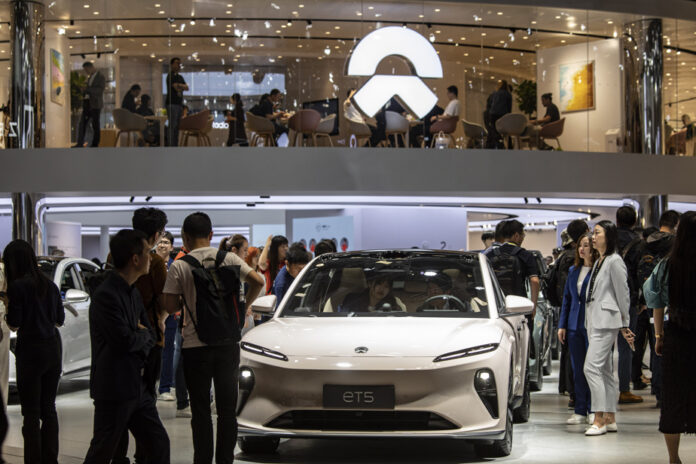(Shanghai) Nio, a Chinese electric car maker that competes with Tesla, employs 11,000 people in research and development but only sells 8,000 cars a month.
The company has invested so much in robots that one of its factories employs just 30 technicians to build 300,000 electric car motors a year. Nio offers $480 augmented reality glasses for each seat in its cars and has launched a cell phone that interacts with the car’s self-driving system.
And none of this is profitable. Nio lost $1.1 billion from April to June, or $48,000 per car sold.
When Nio nearly ran out of cash in 2020, a local government immediately injected $1.4 billion for a 24% stake, and a state-controlled bank led a group of other lenders to inject an additional $2.2 billion.
Today, Nio embodies China’s dominance in electric vehicle innovation and manufacturing, underscoring the threat it poses to traditional automotive powerhouses in Europe and the United States.
The United Auto Workers union strike at three Detroit automakers, now in its third week, is at the heart of a dispute over electric vehicles: The companies say they must invest billions of dollars to revamp their operations , while workers say they must defend their jobs against automation and technology while increasing their wages.
On Wednesday, European politicians worried about the surge in Chinese exports formally launched an investigation into whether electric car makers in China received government subsidies, a move that could lead Europe to impose tariffs. Chinese exports of electric vehicles have increased by 851% over the past three years, mainly to Europe.
The European Union’s investigation is geopolitically complex: many of Europe’s largest companies have ties to the Chinese market, and China is prepared to take retaliatory measures.
China’s Commerce Ministry denounced the investigation Wednesday, calling it “blatant protectionist behavior that will seriously disrupt and distort the global automobile industry’s supply chain.”
Companies like Nio, which spend a lot on marketing in Germany and other European countries, need to export. The question is whether they can sell enough cars to justify their enormous research and investment efforts.
“Actually, I don’t care about manufacturing capacity or volume, just about demand,” William Li, Nio’s chairman and CEO, said at a news conference in Shanghai.
As U.S. and European manufacturers scramble to catch up, Chinese automakers are first in the world in a critical aspect of the electric vehicle supply chain: battery technology. They were the first to develop new chemical batteries that made it possible to drive long distances at a significantly reduced cost. China also dominates the production of electric motors and the design of high-efficiency systems that connect batteries and motors.
Salaries also tend to be lower in China. Auto workers in big cities like Shanghai earn about $41,000 a year in wages and benefits, while workers in cities in the country’s interior earn much less.
In contrast, Ford Motor said its workers earned an average of $150,830 a year in salary and benefits. The UAW is seeking a 40 percent pay increase over four years, as well as one paid day off per week.
As Nio’s new electric motor factory shows, Chinese car manufacturing is now one of the most automated in the world. U.S. automakers are finding they have to buy industrial robots and other automation systems from Chinese suppliers, says Michael Dunne, a San Diego auto analyst and China expert.
“They look around and ask whether America has anywhere near their automation capacity, and the answer is no,” said Mr. Dunne, a former chairman of General Motors Indonesia.
Paul Gong, head of Asia automotive research for UBS Bank, predicted that Chinese automakers would capture a third of the global auto market by the end of the decade. Much of the forecast growth is due to Chinese manufacturers increasing their share of the European market from the current 3% to 20%.
In China, he said, “the competition is so fierce that it’s pushing every automaker to develop new technologies.”
Not all Chinese electric vehicle companies are losing money. BYD, the electric car leader in China and the world, tripled its profits to $2 billion in the first half of this year. BYD makes its own batteries and is a very efficient manufacturer.
UBS researchers teamed up with an engineering firm to take apart a BYD Seal electric car. They found that the Seal hatchback cost at least 35% less to build than a slightly smaller car of similar quality, the Volkswagen ID.3.
The global market can expect many more exports from BYD: the company recently ordered its own fleet of the largest transoceanic ships ever built to transport cars from Chinese shipyards.
In addition to Europe, Chinese brands are reporting rising auto sales in markets ranging from Australia to the Middle East to Latin America. The only market where Chinese cars have a negligible share and are not expected to gain ground is the United States.
In 2018, Robert Lighthizer, President Donald Trump’s trade representative, imposed a 25% tariff on all cars imported from China. The Biden administration created an electric vehicle subsidy proposal that excludes Chinese cars.















